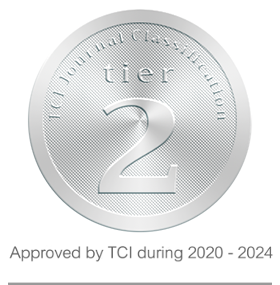Effects of Disinfectant, Cytokinin, and Chlorine Dioxide on Multiple Shoot Induction of Curcuma aromatica Salisb. in Sterile Condition
Keywords:
Mercuric chloride, Plant growth regulators, Contamination, BacteriaAbstract
Wild turmeric (Curcuma aromatica Salisb.) belongs to the family Zingiberaceae. This plant is used in cosmetic formulations and traditional medicinal applications. Naturally, there aren't many seeds in C. aromatica Salisb, which makes it challenging to grow new cultivars or enhance existing types. Therefore, the objectives of this research were to study the appropriate type and concentration of disinfectant against contamination of the explant, and to study the effect of cytokinin on multiple shoot induction. The result showed that 0.1% Mercuric chloride for 10 minutes gave the lowest contamination at 26.67±5.77% and the highest germination at 53.33±5.77%. For sterile explants, the effects of various types and concentrations of cytokinin on multiple shoot induction were investigated. The highest number of shoots, at 3.11±0.69 shoots/explant, was obtained from shoots cultured on MS medium supplemented with 0.5 mg/L 6-Benzyladenine and 0.25 mg/L Thidiazuron For explants contaminated with bacteria, they were cultured on medium supplemented with chlorine dioxide to reduce contamination. The culture medium supplemented with 19.2 mg/L of chlorine dioxide (9.6 mg/L, two times) produced the greatest results in 100% reducing contamination.
References
Al-Otoum, F., Al-Ghauti, M.A. and Ahmed, T.A. 2016. Disinfection by-products of chlorine dioxide (chlorite, chlorate and trihalomethanes): Occurrence in drinking Water in Qatar. Chemosphere 164: 649-656.
Boontim, N. 2017. Curcuma aromatica Salisb. Available from: https://stri.cmu.ac.th/article_detail.php?id=73 . [access on 2 July 2023]. (in Thai)
Cardoso, J.C., and Silve, J.A.T. 2012. Micropropagation of gerbera using cholorine dioxide (ClO2) to sterilize the culture medium. In Vitro Cellular and Developmental Biology-Plant 48(3): 362-368.
Cardoso, J.C., and Imthurn, A.C.P. 2018. Easy and efficient chemical sterilization of the culture medium for in vitro growth of gerbera using chlorine dioxide (ClO2). Ornamental Horticulture 24(3): 218-224.
Gordon, G., and Rosenblatt, A.A. 2005. Chlorine dioxide: the current state of the art. Science and Engineering 27: 203–207.
Huang, J., Wang, L., Ren, L., Ma, N.Q. and Juli, F. 1997. Disinfection effect of chlorine dioxide on bacteria in water. Water Research 31: 607-613.
Kalawong, S. 2018. Plant tissue culture for agriculture. Bangkok: Agriculture and Agricultural Technology Bansomdejchaopraya Rajabhat University. (in Thai)
Kamoltham, M., Puconsan, S. and Chanapan, S. 2016. Plant tissue culture of Kaempferia parviflora. Songklanakarin Journalof Plant Science 3 (Suppl.) (II) MO2: 74-78. (in Thai)
Kasam, W., Wangwibulkit, M. and Laohavisuti, N. 2020. Effect of chlorine dioxide (ClO2) on sterilization in micropropagation of Anubias sp. ‘White’. Journal of Fisheries Technology Research 14(1): 65-72. (in Thai)
Keng, C.L. and Hing, T.W. 2004. In vitro propagation of Zingiberaceae species with medicinal properties. Journal of Plant Biotechnology 6: 181-188.
Kittisak, C. 2013. Influence of commercial bleach on sterilization of Persian Violet (Exacum affine Balf. f. ex Regel) tissue culture media. Rajabhat Journal of Sciences, Humanities and Social Sciences 14(2): 35–44. (in Thai)
Laohavisuti, N., Ruangdej, U., Seesanong, S. and Wangwibulkit, S. 2017. Effect of disinfectants and plant growth regulator in aquatic plant Bucephalandra sp. Micropropagation. King Mongkut's Agricultural Journal 35(2): 95-103. (in Thai)
Madhale, S. V. 2016. Effect of HgCl2 on surface sterilization of explants of Momordica Cymbalaria hook. f. Journal of Science Research International 2(1): 39-43.
Muangkaewngam, A. 2016. Micropropagation of white torch ginger. Songklanakarin Journal of Plant Science 3 (Suppl.)(II): M02/8-11. (in Thai)
Murashige, T.R. and Skoog, F. 1962. A revised medium for rapid growth and bioassays with tobacco tissue cultures. Physiology Plant 15: 473-497.
Noppasee, P., Wansanit, P., Rungrueng, P., Rittirat, S., Suwanno, S., and Kalawong, S. 2022. Effect of chlorine dioxide on in vitro contaminated plant and plant nursery by azolla-mixed plant material of Curcuma comosa. Journal of Science, Engineering and Technology 2(2): 36-46. (in Thai)
Nature Products. 2007. Zingiberaceae Curcuma aromatic Salisb. Available from: http://www.natureproducts.net/Forest_Products/Gingers/ Curcuma aromatica.html. [access on 25 July 2020].
National Library of Medicine. 2016. Sodium Hypochlorite. Available from: https://pubchem.ncbi.nlm.nih.gov/compound/Sodium-Hypochlorite. [access on 7 April 2024].
Neera, S., Soonthorn, W., Mongkolpun. P. and Hongpukdee, P. 2014. Effect of cytokinins and coconut water on in vitro shoot induction of Kaentawan (Helianthus tuberous L.). Khon Kaen Agriculture Journal 42(Suppl. 3): 328-334. (in Thai)
Nura, M.U., Thaigarajan, P., Nafiu, A. and Seok-Ming, T. 2020. Phytochemical and pharmacological properties of Curcuma aromatic Salisb (wild turmeric). Journal of Applied Pharmaceutical Science 10(10): 180-194.
Pongchawee, K., Pipatcharoenchai, W. Pradissan, R. and Kanthrong, W. 2011. Tissue Culture of Aquatic Plant Cryptocoryne affinis Hook. Bangkok: Inland Fisheries Research and Develop Bureau, Department of Fisheries. (in Thai)
Pugabhang, B., Saensouk, S. and Saensouk, P. 2016. Tissue culture of Curcuma pierreana Gagnep. for conservation of rare plant in Thailand. KKU Science Journal 44(2): 294-306. (in Thai)
Pumisutapon, P., Saisueb. S. and Rodpradit, S. 2018. Studies on surface sterilization and callus induction in Selaginella. Agricultural Science Journal 49(Suppl.): 270-272. (in Thai)
Srichuay, W., and Te-chato, S. 2014. Effect of chlorine dioxide (ClO2) on sterilization in micropropagation of pineapple cv. Phulae by bioreactor system. Khon Kaen Agriculture Journal 42 (Suppl3): 75-80.
Sukontharat, P., Khawniam, T. and Te-chato, S. 2016. Micropagation of Curcuma longa Linn. by tissue culture from ex vitro sprouted rhizome. Songklanakarin Journal of Plant Science 2(2): 36-40. (in Thai)
Vilayheuang, K. and Chinachit, W. 2008. Tissue culture of Curcuma aromatica Salisb. Khon Kaen Agriculture Journal 36 (Suppl.): 229-233. (in Thai)
Yang, X., Guo, W. and Lee, W. 2013. Formation of disinfection byproducts upon chlorine dioxide peroxidation followed by chlorination or chlorination of natural organic matter. Chemosphere 91(11): 1477-1485.
Downloads
Published
How to Cite
Issue
Section
License
Copyright (c) 2024 Songklanakarin Journal of Plant Science

This work is licensed under a Creative Commons Attribution-NonCommercial-NoDerivatives 4.0 International License.



